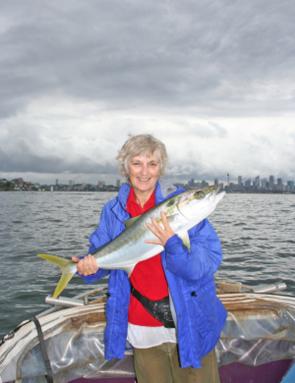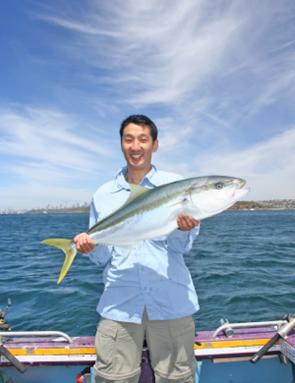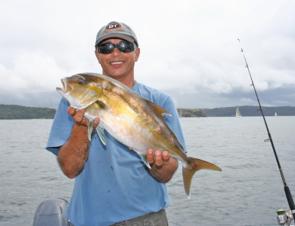Sydney Harbour kingies move in about October. For some reason their distribution then is limited to The Spit and lower Middle Harbour and generally up around Goat Island.
They are usually bigger than the average Summer fish, from 70cm to 120 cm.
There are no visual or electronic signs of them; the only way you will know they are there is to fish for them.
They don’t come near the surface and they mostly hold under the marinas and the moorings, making them hard to find on the sounder. The major stronghold of arrow squid is in this area and my bet is that this is why the kings are there, too.
About November the rats come in, the fish that swarm throughout the Harbour all Summer and Autumn.
The first signs are on the surface, among the bonito, tailor and salmon on the lower Harbour.
The kings are hard to catch and your best bet is with a fly. They are feeding on ‘eyes’ (tiny baitfish) and it’s hard to interest them in anything else.
Once they go off the ‘eyes’, they move in around the marker buoys and yacht moorings, often just before Christmas.
Now they are much less selective and this is the time to catch large numbers of them on squid, soft stickbaits and flies.
You can see the fish and they appear on the sounder. They range from 50cm to 70cm, while those bigger fish of November move offshore until about mid-January.
This goes a long way to explaining why the fishing seems to go quiet during this period after what seems a very good start to the season.
By mid-February they will be throughout the Harbour, as far up as Cockatoo Island and Bantry Bay in Middle Harbour, depending on rainfall and where the squid go. North Harbour will be thick with them, too.
They are generally going nuts by this stage and it’s a sorrowful day when you can’t catch at least a couple.
By mid-April you won’t get too many around the markers but they will still be going crazy in Middle Harbour. Some bigger fish move in again around the deeper markers and The Spit, and in some of the deeper spots between Watsons and Rushcutters bays.
By July they have all but gone back offshore in search of warmer water and you are lucky if you get any in the Harbor.
I have caught fish big and small around the Wedding Cakes, Neilson Park and North Head in Winter and early Spring but there is no consistency or pattern.
It seems to be taking us a long time to break out of the old, bad, traditional habit of using live yellowtail for kings (and jewfish, for that matter).
Live yakkas for kings are now an historical bait. Tackle technology improves and we are finding better techniques and baits to catch fish all the time. It’s called progress and now in 2009 the best bait for kingies is squid – just as it always has been.
Kingies will accept a wide range of baits and techniques. They will pick up a stray bream bait, grab a trolled minnow lure, eat the occasional live bait and pick up a crab drifted down for groper; increased numbers of Kings are making them easier to catch.
If you want to catch the occasional king, the above mentioned methods and baits will do. If you want to catch a lot of kingies all the time then there is only one bait and two types of lures.
If you learn to catch squid you will always catch a lot of kings and that’s the only way I know to do it. If you go to the fish markets and buy very fresh squid, you will catch a few kings sometimes.
If you want to catch them on lures a lot, you must use 6” or 9” soft stickbaits or saltwater flies. Poppers are OK for a few kings occasionally
Soft stickbaits, particularly Slug-Gos and Silstar 9” Slapsticks, are awesome lures on a whole range of species but particularly kingies.
They have been used in Australia for over 10 years and it’s just that they are unpopular and about the only thing that seems to really like them, apart from a handful of anglers, are the kingfish.
The challenge is there for a better kingie lure, though. White is the best colour.
That challenge doesn’t include flies, which are also very good for kings. Their major drawback is that they are much harder to deliver, even more so if it is windy or rough. Good flies include blue or silver Surf Candy and Deceivers in white.
Big kingies like whole live squid but small ones don’t. Big kingies will just as happily take a squid head. So by using a squid head you will get lots of big and small kingies.
If you use live squid you will get fewer fish but they will be bigger on average.
A whole squid gut is exceptionally good bait and the best berley that you can use for kings. It’s all about the guts.
Use the guts and especially the ink to entice the fish. Burst the ink sac before you send the bait down or you can let the first king burst it for you.
The gut is always the first bait to go, which must mean it’s the best. Strips of squid cut from the tube are good, particularly after the guts and heads have the school in a frenzy. Rub it all in ink.
Kingies mostly hold from mid water down so obviously this is a good place to present your bait
You will find them really feeding at high tide and the first two hours of the run out, early morning and late afternoon. They are also good times to catch squid.
You won’t have to worry too much about tides or time of day if you pay close attention to what I said earlier about the bait the guts and the ink.
Kings are easily turned on and off if you know what buttons to push.
The worst thing you can do is persist in presenting something that has been rejected.
A school of followers can be turned into a school of takers by something as simple as changing the presentation angle of the lures or bait.
If they follow a lure or show interest in a bait more than three times without taking it, don’t present it again. The more you shove it in their faces, the more they’ll reject it
Change lure size, let it sink, change presentation angle or, best of all, go away, try another spot and come back in half an hour.
To turn them on, surprise them.
Rock up to a spot noisily. Throw your anchor with a big splash and then get all your baits out there quickly.
Let the baits sink to the required depth and then rip them back in.
Just as an excited, dumb dog does stupid things, so do kingies.
As soon as the anchor hits the water they come straight over to see what is happening.
The key is to not give them too much time to think about it. Trick them into an impulse attack. Action excites them but not for long, so work quickly
You are better to have five or six baits in the water rather than just a few – this is more likely to excite them.
Fish with your reel in gear with your normal fighting drag.
Don’t feed kingies line when they take your bait. Once a take is felt, lower the rod and move with the fish. Once the rod reaches the water, it’s time to strike.
By-catch includes the occasional samson fish, amberjack and possibly rainbow runner. Once they get big, they become harder to tell apart
The hardest to distinguish are amberjack and kingies; even as juveniles they are similar in colour and body shape.
Side by side, the differences are obvious. Amberjack are rounder and fuller over the top of the head and have a slightly bigger and more forward eye.
They are generally darker and have a distinct yellow band running the length of their body. The tail is not yellow like a kingie’s but rather chocolate brown.
Samson fish, as juveniles, are very distinct and couldn’t possibly be confused with kings or Amberjack. They are very ‘trevally’-shaped and the colour is a blotchy mix of brown, yellow and white. According to Grant’s Guide to Fishes, they have red teeth although on the juveniles that is only just apparent.
Rainbow runners are very elongated, have a bigger tail and a pointy snout. Bright iridescent blue-purple stripes run the length of their body on a yellowish background
Of course you can’t go wrong with fin counts but that’s way too boring to go into here. If you are really interested, buy a good ID book.
Reads: 11591
Big soft stickbaits like the Slug-Go 9” are awesome kingie lures in Sydney Harbour.

When they lose their inhibitions, Harbour kings can come on thick and fast.

Where else in the world can you encounter hard-fighting fish like kingies against such a backdrop?

Springtime and structure hold the key to securing the bigger Harbour kingfish.




